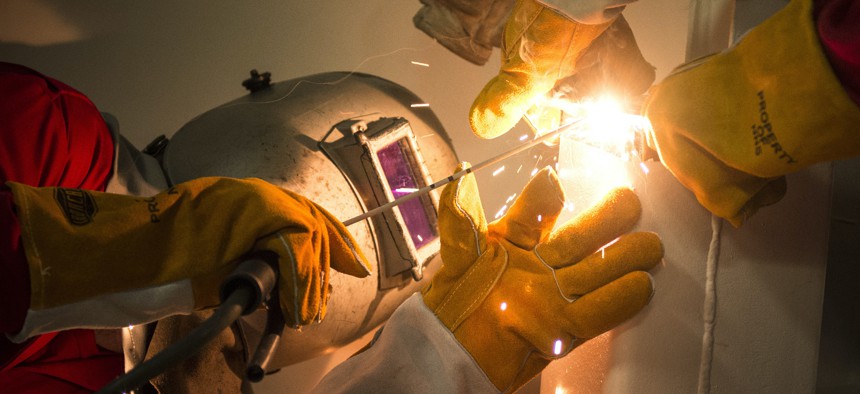
Shaun Worones, a Newport News Shipbuilding welder, seals the cover to an island landing time capsule, July 11, 2013. U.S. Navy / Mass Communication Specialist 1st Class Joshua J. Wahl
Defense Firms Should Hire Ukrainian, Afghan Refugees, Navy’s Top Admiral Urges
Adm. Mike Gilday touts shipbuilding apprentice programs as perfect landing spots.
Here’s a suggestion for U.S. defense firms struggling to find skilled workers to build ships and weapons, straight from the chief of naval operations: hire Ukrainian and Afghan refugees.
Adm. Mike Gilday touted the apprenticeship programs run by the country’s major shipyards, which are always looking for new talent, but especially now as the Navy looks to bulk up its fleet with newer, more advanced warships.
“Think about the…Ukrainians and the…Afghans that are either coming to this country or have already set foot on our shores...Find a path to attract them into those apprenticeship programs,” Gilday said Monday at the Navy League’s Sea Air Space convention in National Harbor, Maryland, a conference largely attended by by defense industry executives.
“You offer well-paying jobs with a career of advancement that allow them to send their kids to college and to buy a home,” he said. “Think about how powerful that would be to somebody emigrating to this country that wants to give back.”
More than 74,000 Afghans were admitted to the United States last year as Kabul fell to the Taliban and the U.S. military withdrew from the country. The Biden administration said it would admit up to 100,000 Ukrainians who have fled Russia's invasion. More than 4 million have fled Ukraine, largely into neighboring countries in Europe.
Much of the defense industry is struggling to find skilled workers, but shipyards have it particularly bad. Last year, Jon Mason, the vice president of human resources at General Dynamics’ Bath Iron Works in Maine, told Defense One that the decline in manufacturing jobs across New England had reduced the number of skilled workers.
“We used to have shoe factories, textiles, more major construction firms, paper mills, and we could hire from that talent pool,” Mason said. “All of those industries I've just listed are gone. And we're the only one left standing in the state.”




